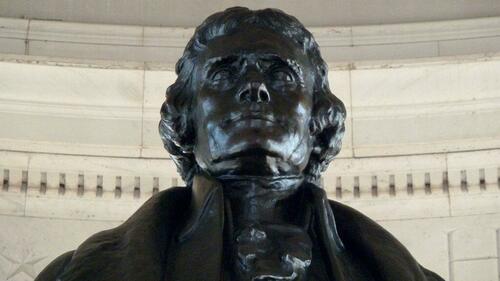Thomas Jefferson’s Blueprint For Handling The National Debt
Share

Thomas Jefferson’s Blueprint For Handling The National Debt
Authored by Michael Maharrey via SchiffGold.com,
The way Thomas Jefferson handled the national debt should serve as a blueprint for today. But instead, modern presidents look more like college students on a spending spree with their first credit cards.
As Democrats and Republicans shadowbox in their fake debt ceiling fight, the US government continues to spend money at an extraordinary clip. Just four months into fiscal 2023 and the US federal budget deficit is already approaching half a trillion dollars.
We all know how the debt ceiling fight will end. Congress will raise the borrowing limit and the government will keep right on spending money.
That reveals the nature of the problem. It’s not the debt ceiling. It’s the spending.
When Donald Trump took office in January 2017, he inherited a $19.95 trillion federal debt. He handed over a $27.75 trillion debt to Joe Biden. In just four years, the Trump administration added $7.8 trillion to the national debt.
Joe Biden took up right where Trump left off. In October, the national debt blew past $31 trillion. It now stands at $31.46 trillion. It will remain there until the fake debt ceiling fight resolves and it will then spike quickly toward $32 trillion.
But this isn’t just a Trump/Biden problem. Every modern president inherited a huge national debt and managed to expand it during their time in office. In fact, since 1940, every successive presidential administration has spent more than the previous administration in inflation-adjusted dollars.
But there was a time when some presidents took paying off Uncle Sam’s debts seriously. For instance, Thomas Jefferson faced a huge national debt when he took office in 1800. But unlike his modern counterparts, he didn’t grow it further. In
Continue reading Thomas Jefferson's Blueprint For Handling The National Debt at ZeroHedge.














